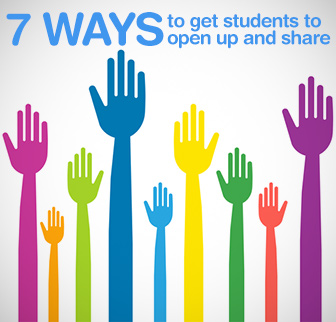Just Say No to Yes and No: the Why's and How's of Avoiding Closed Questions


Yet, this is information that is essential to our goals: we need to know as much as we can (without getting too personal) to tailor activities to their needs, to create rapport, or simply get to know them better. This is particularly challenging with beginners with limited vocabulary or who are very self-conscious about their English-speaking skills. Here are great ways to get your students to open up, without your having to give them the third degree.

How unfair is it to expect students to tell you all about themselves, without taking the time to reciprocate? If you want each of your students to tell the class a little bit about themselves, lead by example and go first. They’ll be more willing to share after you’ve done it.
One student stands in front of the class, and the rest ask him/her questions with the goal of obtaining a “Yes!” This is a game that can be played with any number of structures: Simple Present (“Do you…?”); Simple Past (“Did you…?”); Present Perfect (“Have you ever…?”); etc…When one student obtains 5 affirmative responses from their classmate, they win!
If you want students to share their views on a specific topic, it may be a little hard to get the discussion going by asking a question up front. Try reading a short piece on the subject first, followed by some comprehension questions, and THEN ask students to weigh in with their opinions.
If students are tense about sharing, particularly on the first day of class, break the ice with some comic relief: introduce yourself (using a very funny, made up name) and with a straight face, tell them you are 82 years old. Unless you have an extremely tense class (and thankfully, that is rarely the case) some of your students should understand that it’s a joke. Then you confess to the ruse and tell them your real name/age, which is a perfect lead in to your asking them theirs. The same can be done for professions, hobbies, number of languages you speak, etc…Make a false, exaggerated statement, wait till they catch on, and once they’re a bit more relaxed, they’ll be more willing to share their personal info!
This activity is also a fantastic ice-breaker. Divide students into pairs, and have them ask each other questions about their family, background, profession, where/how long they’ve studied English, etc…Once all the interviews have been completed, students report on what they’ve learned about their partner to the rest of the class.
Another great way to share personal info indirectly is through a visual aid. Have each student bring a personal photo to class: this will be their profile pic. Give each student a piece of construction paper or poster board and ask them to create a profile; it doesn’t have to be flashy or glitzy, perhaps something as simple as this:

Put up the profiles where they will be visible to all, like the bulletin board. You also have the option to have each student create a profile for a classmate, thus forcing them to ask each other questions. Don’t be afraid to try this with adult learners; Business English students may create their own resume in English, which you’ll keep on file.
What happens when students are too eager to share? This is often the case with young learners who bring their newest toy to class or interrupt the lesson to show you their most recent addition to their collection of knee scars (and of course, go into a play by play account of how they fell off their bike). While it’s great that they spontaneously wish to share these things, these outbursts disrupt the class, and often lead to more students jumping out of their seats to compare injuries or share their own experience.
So, here’s what you can do. Set aside a time to share, perhaps the first or last five minutes of class. Start the class by asking your students if they did anything interesting they’d like to share. On the other hand, when a student interrupts the lesson to share something, simply tell them you’ll want to hear all about it, at the end of class.
If someone is uncomfortable talking about a certain personal topic, respect that and never pry. Create a fun, safe environment for your students to share information about themselves, and they will open up!
How do you get students to share? I’ve already shared mine, so don’t be shy and share your tips below!